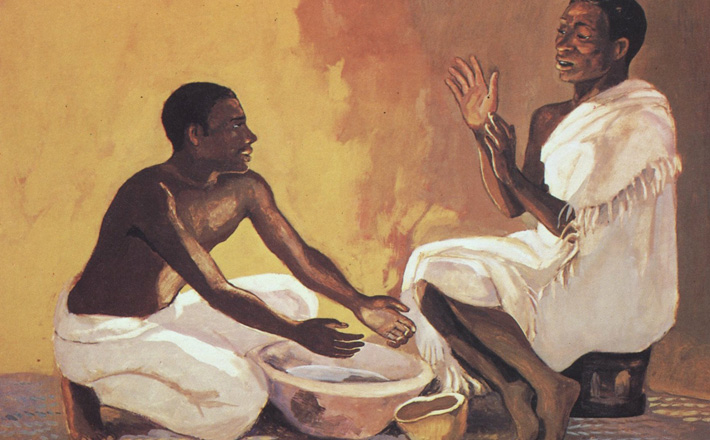Commentary on 1 Corinthians 11:23-26
Many preachers will immediately recognize this text in terms of its liturgical use.
This text serves as the basis for the words of institution in the Eucharistic liturgy of many denominations. To understand Paul’s inclusion of this early Christian tradition here, it is important to focus beyond just these four verses. Consideration should also be given to what is going on within the Corinthian church causing Paul to write these words to them and to how these verses relate to Paul’s broader theology regarding Christ’s death.
Throughout 1 Corinthians, Paul is dealing with fractured communal unity caused by the attitudes and actions of various groups within the Corinthian congregation. The letter’s overarching theme involves his appeal that there not be schisms among the Corinthians, but that they be continuously united in the same attitude and the same resolve (1 Corinthians 1:10). When it comes to celebrating the Lord’s Supper, however, that is clearly not the case. In fact, Paul goes so far to say that they are not eating the Lord’s Supper when they come together (1 Corinthians 11:20).
So what is the Corinthians’ problem? Essentially, the social realities and patterns of first century Greco-Roman interactions are being played in the Corinthians’ worship life. Unlike other first century, social associations, this church was not socially homogenous. Instead, there were members from across the social spectrum: well to do, slaves, manual laborers, women, and men (see Paul’s comments in 1 Corinthians 1:16,26-28; 7:20-24; 11:3-9). Unfortunately, people did not check these significant social differences at the door when they all came together for worship. On the one hand, the gathering of the whole church coming together would have been in the house of a wealthy member. On the other hand, not all were gathering at the same time. Those on the higher end of the social spectrum were able to arrive earlier while those on the lower end (slaves and manual labors) could only arrive after their responsibilities were fulfilled. Upon arriving, the so-called “haves” would have been seated in the host’s dining area which typically could accommodate about nine people in a reclining position. As was the social norm, they would have been served the better food and wine because they were on the same social level as their host. Later, when the so-called “have nots” arrived, they would have had to occupy other open space in the patron’s house such as the atrium, and either they ate leftovers or nothing at all (1 Corinthians 11:21-22,33-34). Because the unity of the community (which is integral to the reality of the Lord’s Supper) is severely fractured by such social observances, Paul feels the need to chastise the “haves” among the Corinthians (see 11:17, 22, 27-30).
To reunite this fractured community, Paul returns them to the true meaning and reality of the Lord’s Supper. In the previous chapter, Paul highlighted how the cup involves participation in the blood of Christ, and the bread involves participation in the body of Christ (1 Corinthians 10:16). By this he means that in the supper we experience anew the salvific reality of Christ’s death for us (also recalling what he had said about Christ’s death in 1 Corinthians 1:18-2:8; 5:6-8; 6:19-20; 8:11-12). Beginning in 1 Corinthians 11:23 he holds up the foundational tradition of this sacred meal which he first received and which he had handed to the Corinthians. When he says that he received it from the Lord (11:23a), he is not referring to a mystical vision he experienced. Rather he means that this tradition’s origin is rooted in Jesus’ own words and actions.
Unfortunately, almost all of our biblical translation and our subsequent liturgical traditions make a grave error in rendering Paul’s words in 1 Corinthians 11:23b. The common wording is “on the night in which he was betrayed.” This wording puts the meal’s initial focus on Judas’ treachery. The issue at hand involves the Greek word paradidomi which is best translated as “hand over” rather than “betray”. This word forms the bedrock of Christian tradition regarding Jesus’ death. It is used over fifty times in the gospels in association with Jesus’ passion. It is the exact same word which denotes the parallel actions of Judas, the religious authorities, and Pilate. Its use in Jesus’ passion is rooted in its use in Isaiah 53:6,12. Paul uses this same word in relationship to Jesus’ death in Romans 4:25; 8:32; Galatians 2:20. Thus its meaning in 1 Corinthians 11:23 does not refer to Judas’ betrayal. Rather it refers to God’s plan in which Jesus was handed over to die for us and Jesus’ faithfulness to this plan. Hence 11:23b should be read as “on the night in which he was handed over” so that the initial Eucharistic focus is not on Judas’ treachery but on God’s plan to enact salvation for us through Jesus’ death.
While parallel traditions are evident in the last supper scenes of the synoptic gospels (see Matthew 26:26-28; Mark 14:22-24; Luke 22:19-20), Paul’s rendering is the only one in which remembrance is linked to both the bread and the cup. Rooted in his Judaic background, Paul is stressing remembrance as much more than our memory activity. Remembrance includes both our recollection of God’s past saving work for God’s people and the realization that we participate in that past saving work of God. So in the Lord’s Supper we are not just recalling how Jesus died for us. Through this sacred meal we are also participating anew in the Christ’s death for us. This is parallel to Paul’s understanding of baptism as our inclusion into Christ’s death so that we were co-crucified with Christ (see Romans 6:3-8; Galatians 2:20-21).
While 1 Corinthians 11:26 was probably not part of the original tradition Paul received, it does seal Paul’s instructions on the Lord’s Supper. For Paul the celebration of the Lord’s Supper is both participation in Christ’s death and proclamation of Christ’s death. This proclamation was the foundation of the Corinthian community in the first place (recalling 2:1-5). Hence their oneness established through the proclamation of Christ’s death is to be manifested in their celebration of the meal through which the many are the one body who died for them (10:17). Thus for Paul to discern the body through participating in this meal involves discerning both the body of Christ via the bread AND the unity that all members share as the one body of Christ via the proclamation of Christ’s death.


March 24, 2016